
History of Putian
蒲田的历史


Source: Ai (2025) Chen Guangda on horseback
Putian was founded by Emperor Chen Guangda (陈光大) of the Chen Dynasty in 568 AD. During his travels, he came across a marshy grassland and promptly named it 蒲田 (Putian).
The grass on the wetland was later identified as Porphyra (紫菜), a special kind of seaweed that grows abundantly in shallow coastal waters.
The area later became known by several names -- Hinghua (兴化), Xing’an (兴安), Puxian (莆仙), Puyang (莆阳), and Licheng (荔城) -- as it underwent transformations under different administrations. The name Licheng (荔城) itself is derived from the lychee fruit, and it could be considered the sweetest name -- literally.
Each name reflects a unique chapter in Putian's history, marking the cultural and administrative shifts over the centuries. The evolution of its name signifies more than just a title change; it embodies the rich tapestry of the region's geographical and social transformation.
The earliest evidence of Putian’s founding is found at the Nanshan Guanghua Temple (南山广化寺), which was built during the Chen Dynasty. It is believed to be the oldest Buddhist temple in Putian.
Nan Shan Guang Hua Temple
(南山光化寺, 莆田)
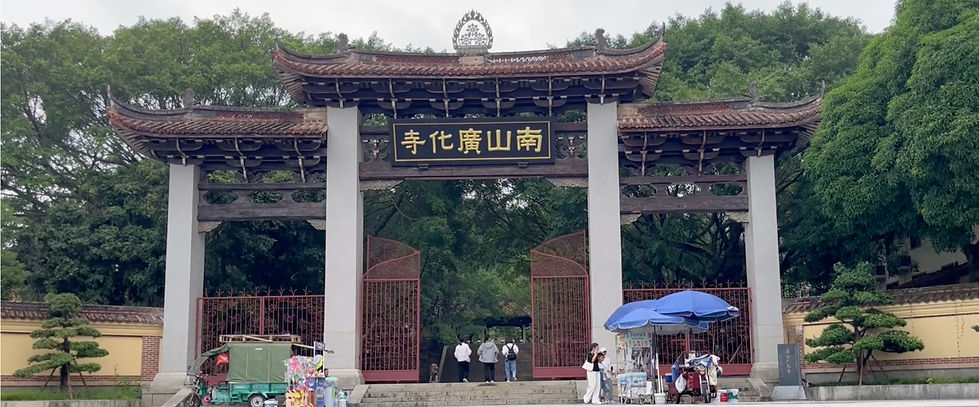
Source: Jason Ong & 林洲
Source: Jason Ong & 林洲
Introduction
The inscription at the Nanshan Guanghua Temple in Putian holds two important clues to the founding of Putian and the early history of the people later known as the Hinghua.
The Hinghua people have a long and rich history. As modern-day archaeologists have uncovered, our ancestors lived in the southern region for nearly as long as Chinese civilization has existed in the north. This remarkable discovery challenges the popular belief that the Hinghua people were migrants from Henan Province.
It has also been proven that the ancestors of the Hinghua had already established a thriving civilization in the region during that time.
As Professor Chen states:
"兴化地区已发现的新石器古文化遗址表明,早在 5500-3500 多年前,先民们已在兴化湾南日岛、埭头后郑、仙游双桥以及莆城东岩山这些地域周围,从事原始农业和渔猎活动,繁衍生息。从出土的文物看,早在三千多年前,兴化先民已在常太山区繁衍生息和创造文明."
“The Neolithic cultural sites discovered in the Hinghua area show that as early as 5,500 to 3,500 years ago, the ancestors were already engaged in primitive agriculture, fishing, hunting, and settlement and population growth around Nanri Island (南日岛) in Hinghua Bay, Houzheng in Daitou, Shuangqiao in Xianyou, and Yanshan in the eastern region of Pucheng. From the unearthed relics, it is evident that as early as 3,000 years ago, the ancestors of the Hinghua people were living and creating a flourishing civilization in the Changtai Mountain region.”
During the Warring States period, there was significant movement of troops and people from the north to the south. The north, populated primarily by Han people, experienced a southward migration, eventually leading to the integration of Han migrants with the Ou, Yue, and Min peoples of the south.
According to Professor Chen C.Y., “The unique merging of the Huaxia people and the southern peoples, as they continued to move south, eventually gave rise to a new ethnic and cultural identity known as the Putian people.”
(华夏文明和岡越文明的紧密结合, 孕育出独特的莆田文明).
Therefore, it is technically not wrong to say that some of our ancestors came from Henan, because after more than a thousand years of integration, many of our forebears could indeed have originated from the north. However, the key point is that the Hinghua people were not originally part of the Han Chinese. It was only after a long period of cultural and ethnic blending that we became integrated into the Han identity.
This section will therefore attempt to trace the ancient history of Putian and the Hinghua people, including their glorious period during the Tang and Song Dynasties.
Origin of Putian
Long before the arrival of the Han Chinese from the north, the land later known as Putian was already populated by its own indigenous inhabitants. These early communities were primarily located along the Mulan River and its estuary. As mentioned earlier, archaeologists have also discovered evidence of an ancient civilization on Nanri Island, off the coast of Putian, as well as in the Xinghua Bay area. This was where the first Hinghua people were introduced to Christianity.
The ancient name of Putian (蒲田) evolved over time. The original Chinese word for Putian was indeed ‘蒲田’.
The character '蒲' (Pú) is composed of two elements. The top radical 艹 represents grass, while the bottom part 浦 means estuary or wetland, thus forming the meaning behind ‘蒲’ (Pú).
The second character, ‘田’ (Tián), means field or farm. Together, the term ‘蒲田’ (Putian) literally means “Wet Grass Field” or “Marshy Farmland.” The vegetation was described as grass because it clings to hard surfaces in shallow waters and reproduces there.
This aquatic plant is also known by its scientific name, Porphyra (紫菜).
Unlike typical seaweed, it does not drift with ocean currents and is known for its distinctive flavor when fried. According to Wang, Zhu, & Yao (2023), “It has high nutritional value, including antioxidant, immune-modulating, anti-aging, and hypoglycemic effects.” ScienceDirect also identifies it as a potential anti-diabetes agent.

As much of Putian was an estuarine region, a heavy downpour during high tide could easily cause the river to swell, resulting in widespread flooding. In times of such suffering, the people would seek answers from the spiritual realm. It was believed that the focus had fallen on the Chinese character ‘蒲’. According to legend, the three dots on the left side of the character resembled rain (雨), and in Feng Shui, it was considered a symbol of bad luck. Consequently, the three strokes were removed, and ‘蒲’ became ‘莆’.
Another theory suggested that the name was changed after the water was drained off (Liu, F. Z., 2014b). However, this theory is less likely, as the water level in the estuary is governed by tidal fluctuations.
Regardless of the origin of the name, what truly mattered to the people was that the land was fertile, something of utmost importance to the farmers who lived there (Zhou, 2008a).
In 568 AD, Putian was officially recognized as a geographic and administrative entity by Emperor Chen Guang Da (陈光大) (Chen, C. Y., 2014a, p. 65).
Over time, the area became known as Hinghua (兴化), Xing’an (兴安), Puxian (莆仙), Puyang (莆阳), and Licheng (荔城), reflecting the changes under various dynasties and local governments. The name Licheng (荔城) is actually derived from the lychee fruit, making it arguably the sweetest-sounding name, literally.
By the time Putian became Xing’an Prefecture, according to Professor Chen, many villages in the region already incorporated the word 'Pu', such as:
Púhǎicūn (莆海村), Púshàngcūn (莆上村), Púwěicūn (莆尾村), Shāpúcūn (沙莆村), Xiàpúcūn (下莆村), Dàpúcūn (大莆村), Xiǎopúcūn (小莆村), Púxīncūn (莆心村), Gāngpúcūn (冈莆村), Dàpútián (大莆田), Shàngpúwěi (上莆尾), Púgé (莆隔), Púshàngwéi (莆上围), Púxīnpái (莆心排), Cǎopúzi (草莆子), Kēngxiàpú (坑下莆), etc.
Similarly, when people from Putian migrated to other regions, they often gave new settlements the same name out of nostalgia and cultural continuity. This is why many regions, such as Chao'an and other coastal areas, feature the word ‘Pu’ in their names.
Each village typically consisted of around a hundred households. The Hinghua villagers would fondly address each other with the phrase:
Duh lek hio li nan, nai kah yi.
我们都是同一个村。没有必要这么客气
Wǒmen dōu shì tóng yīgè cūn. Méiyǒu bìyào zhème kèqì
"We are from the same village, no need for such courtesy."
Putian Ancient City Entrance
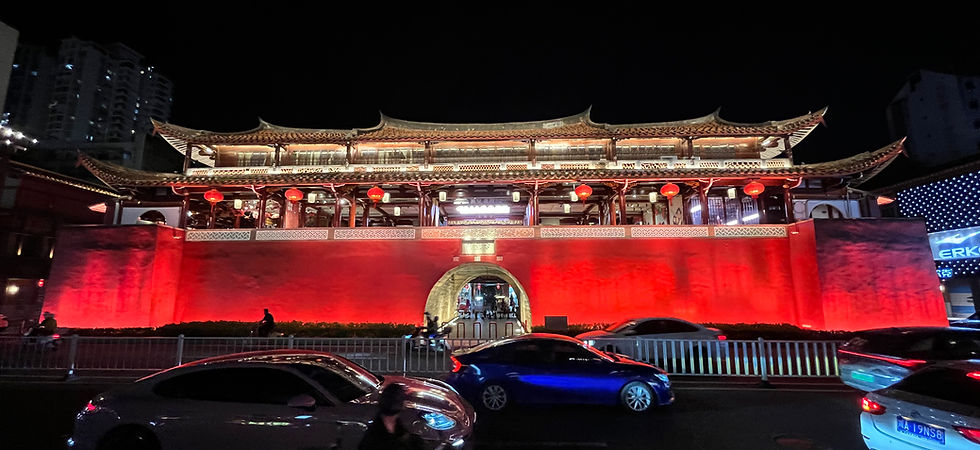
Source: Jason Ong & 林洲
Water Warriors
The people of Putian celebrate the Spring Festival for an entire month, much of which involves offering prayers to the deities for favorable weather that will bring abundant harvests throughout the seasons. Therefore, the Spring Festival is always a joyous occasion, as the revitalized farms lift the livelihood and spirits of the people.
However, their prayers are not always answered, especially when they face two extreme weather conditions within a single year: one is the devastating flood, and the other is drought.
During a flood, heavy downpours swell the rivers, and when this coincides with rising tides at the estuary, a catastrophic flood becomes inevitable. Such floods can be disastrous, as unprecedented water levels may wipe out entire crops, severely impacting the people's economic well-being.
On the other hand, an extreme drought can cause crops to wither and die due to the absence of sufficient water, resulting in equally devastating losses.
Even people from outside the county could not bear to witness the suffering of the farmers. One such benevolent figure was Qian Si Niang. Lady Qian, along with those who followed in her footsteps, valiantly battled extreme weather conditions by constructing dykes -- to mitigate flooding, and retain water for irrigation, and to ease the hardship of the drought season.
Qian Siniang (钱四娘; 1049AD – 1067AD)(Goddess of Water)
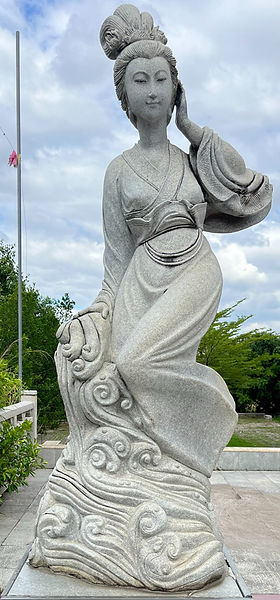
Source: Jason Ong & 林洲
Lady Qian was a native of Zhangle (长乐), Fujian. She came from a prestigious family of imperial officials and displayed remarkable talent from a young age. Her father held an official post in Guangdong Province. Lady Qian was widely revered for her selflessness, particularly for raising funds to assist the needy in Putian.
According to legend, while passing through Putian with her father, she witnessed widespread devastation across the farmland and the suffering of the local people. Deeply moved, she returned to her hometown and successfully raised funds to build a dam that would irrigate farmland along both sides of the Mulan River.
Without any government support, she later returned to Putian and spearheaded a private initiative to construct what would later be known as the Mulan Reservoir (木兰陂; Mùlán Bēi).
Mulan Bei Park

Source: Mulan Bei Park by Jason Ong & Lin Zhou (林洲)
The dam was finally completed. When the rain began to pour, the upper ridges of the dam began to fill with water. But suddenly, the dam collapsed. Devastated and heartbroken, Qian Si Niang could not accept that all the hard work put in by the migrant workers had come to nothing. Overwhelmed by sorrow, she threw herself into the water and tragically passed away at a very young age.
Her selfless dedication to helping the people of Putian deeply touched the hearts of the villagers, who continued to revere her as the Goddess of Water (水女神) (Li, S. H., 2012).
A nearby temple, 协应庙 (Xié Yìng Miào), was dedicated to two significant figures whom the villagers believed were worthy of divine recognition. They were 李长者 (Lǐ Zhǎngzhě), worshipped as the founder, and 钱四娘 (Qián Sìniáng), revered as a secondary goddess (Dean & Zheng, 2009, p. 15). The temple was later officially registered as a recognized place of worship.
What made her service so divine was not just her sacrifice, but the fact that no one asked her to help, she simply saw the suffering and gave everything she had to relieve it.
Her actions became a powerful symbol for many Hinghua in Nanyang, who later returned home to build schools, roads, and infrastructure, and to invest in their hometowns for a better future.
Her sacrifice inspired others to continue her project. Several of these individuals were later honored in the Shi Hui Temple in Putian.
Mulan Bei in Putian

Source: Jason Ong & Lin Zhou (林洲)
Walking across the dam was quite an experience, largely due to the optical disorientation it caused. As the video shows, one side of the lake is calm and still, but as the water rushes into the dam and exits on the other side with a constant roar, the contrasting motion can be disorienting. The uneven stone surface beneath my feet only adds to the challenge of crossing.
Source: Jason Ong & Lin Zhou (林洲)

As the chart shows, in 2023, the floodwaters rose to an alarming 10.57 meters -- the most devastating flood in modern Putian. Even with today’s advanced technology, the flood proved impossible to contain.
Now, imagine Lady Qian and her dedicated team of helpers, using only their bare hands and primitive tools, facing such powerful forces of nature. Their courage and determination were nothing short of extraordinary.
FLOOD IN PUTIAN

Source: Hong Lin
As the picture shows, the town was inundated with floodwaters in 2023. This mirrors the hardships farmers faced in the past, where their crops and livestock could be wiped out in an instant. It is for this reason that the people have always been deeply grateful to those who helped them survive such disasters.
This deep gratitude gave birth to the worship of more than a thousand deities -- many of whom were, in fact, real individuals who had performed extraordinary deeds during their lifetimes. One such example is the Shihui Temple, which is nearly a thousand years old and stands as a lasting tribute to the enduring reverence for those who served the people with selflessness.
圖:世惠祠 (Shihui Temple)
來源:蔡建财 (Cai Jiancai)
Temple of Gratitude
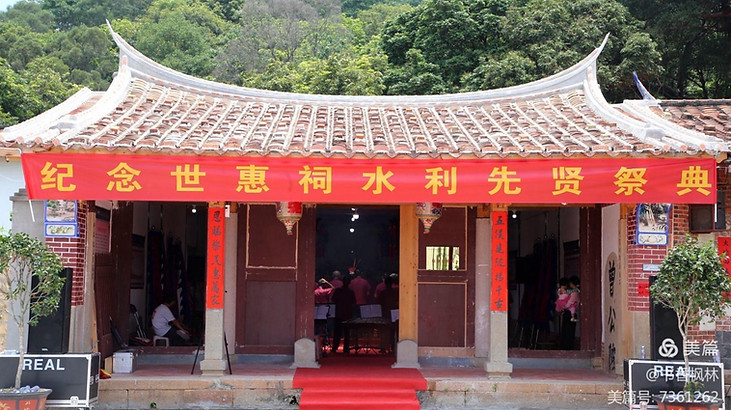
Source: Cai Jiancai
This humble temple houses the images of six revered sages who saved millions of lives and lifted countless others from hardship in ancient Putian.
In Putian, extreme weather has long wreaked havoc on the lives of farmers. Floods and droughts could easily wipe out a year's worth of crops, leading to famine and widespread suffering. Sometimes, droughts would last for years. To confront these twin disasters, courageous sages often rose to the occasion, constructing dams to control floodwaters and irrigate the land. With only primitive tools and the strength of human labor, their efforts were sometimes swept away by powerful water currents.
Disaster often struck when torrential rain coincided with high tide and thunderstorms, amplifying the destructive force. Even today, with advanced technology, catastrophic flooding remains an insurmountable challenge. While nature's power cannot be controlled, these ancient sages understood that water could at least be retained during times of drought or redirected during wet seasons to prevent loss.
This was the spirit that moved extraordinary sages such as He Yu (何玉), Cai Xiang (蔡襄), Liu E (刘谔), Zeng Yonghu (曾用虎), Zhang Nie (章蘖), and later Chen Chunming (陈春溟) to take action. They were the architects behind the life-saving water management systems of Shengshou Pond (胜寿塘), Taihe Pond (太和塘), Xichong Pond (西冲塘), Tunqian Pond (屯前塘), Dong Pond (东塘), and Taiping Dam (太平陂).
The temple dedicated to their legacy is known as the Temple of the Six Dukes (六公祠; Liù Gōng Cí). In ancient China, the title "Duke" was one of the highest among the five ranks of nobility, and this honor signifies the deep respect and gratitude the people held for these sages.
Also known as the Taipingpi Shihui Temple (太平陂师惠庙), it was built in 1132 AD and stands today as a relic of the Song Dynasty. It is located in Meiling Natural Village, Fenglin Village, Wutang Town, Hanjiang District, Putian City. Today, it is officially designated as a Key Cultural Relic Protection Site in Fujian Province.
All Hinghua who return to their ancestral homeland are encouraged to visit this sacred site as a tribute to the sages whose sacrifices made survival and prosperity possible for our ancestors.
Their contributions are no less significant than those of Great Yu (大禹), the legendary king of the Xia Dynasty (c. 2070–1600 BCE), who is celebrated for taming the great floods of the Central Plains. These sages stand as timeless exemplars of courage, ingenuity, and compassion.
I extend my deepest appreciation to Putian scholar, cultural contributor, and historian Cai Jian Cai (蔡建财)
for generously sharing with me the history of Putian. His insights greatly enriched my study tour, and for that, I am profoundly grateful.
Cai Jian Cai
(蔡建财)

蔡建财,莆田涵江梧塘人,
北宋庆历名臣蔡襄第27代裔孙,
福建省作家协会会员、
福建省摄影家协会会员、
莆田市朗诵协会副秘书长、
莆田市楹联学会理事 等
Cai Jiancai has been dedicated to cultural work for over ten years, with a strong focus on preserving and promoting traditional culture. He emphasizes cultural integration and actively participates in both rural and cultural revitalization efforts in Putian. Through his work, he has become a disseminator, advocate, and practitioner of Putian’s traditional heritage.
Passionate about charity and public service, Cai often encourages his family to get involved as well. He integrates the principles of The Four Lessons of Life with his commitment to charity and public welfare, using both to support and empower rural and cultural revitalization. These efforts are mutually reinforcing, creating synergy and promoting the positive values embedded in traditional culture.
Despite his busy schedule, Cai made time to accompany me to several remarkable historical sites, an experience for which I am deeply grateful.
蔡建财,十几年文化实践,着力传统文化传承与传播,着力文化融合,汇入莆田乡村振兴文化振兴当中,做莆仙传统文化传播者、宣讲者、践行者。热心慈善公益事业,常带动家人齐参与,以《了凡四训》、慈善公益理念赋能乡村振兴文化振兴,互补、互促、相融,弘扬传统文化正能量。尽管日程繁忙,他仍坚持带我参观几处引人入胜的历史遗迹,对此我深表感激。
Ancient Administrative System
During the chaos of the Warring States period, the philosopher Mencius proposed replacing the feudal fiefdom system with a more organized structure of Prefectures (州), Counties (縣), Towns (鄉), and Villages (村). The traditional fiefdom system placed land under the control of individuals
-- often warlords -- leading to fragmented governance.
The first state to implement these reforms was the State of Qin, under the legalist reforms of Shang Yang (商鞅; 390–338 BCE), a Chinese philosopher and politician from the Wei State during the Western Zhou Dynasty (Zhang, C. X., 2011).
The following are examples of administrative systems used across different Chinese dynasties:
-
路 (Lù, Road) – used during the Song Dynasty
-
道 (Dào, Road) – used during the Tang and Yuan Dynasties
-
州 (Zhōu, State or Prefecture)
-
府 (Fǔ, Government Office/House)
-
军 (Jūn, Commandery or Military District)
-
县 (Xiàn, County)
-
鄉 (Xiāng, Town)
-
村 (Cūn, Village)
-
省 (Shěng, Province) – formally adopted from the Yuan Dynasty onwards
Ancient Putian’s Jurisdiction and Administrative Evolution
Historically, Putian was the largest county in the region, having jurisdiction over modern-day Xianyou and parts of Fuqing County, including Guangxian, Anxiang, and Suli, as well as Dayang and Zhangyang. Although smaller in territory compared to other major states, Putian was elevated administratively to match seven other key regions: Fuzhou (福州), Jianzhou (建州), Quanzhou (泉州), Zhangzhou (漳州), Tingzhou (汀州), Nanjianzhou (南剑州), and Shaowu (邵武).
Over the centuries, as different dynasties came to power, Putian's administrative status evolved. Its jurisdiction and village boundaries changed frequently, depending on political priorities. For example, Jiangdou (江兜), once under Putian’s jurisdiction, was later reassigned to Fuqing, although the local population remained Hinghua-speaking. The following timeline outlines the major phases of Putian’s administrative transformation:
Timeline of Putian's Administrative Evolution
-
568 AD: Putian County was formally established by Chen Guangda (陈光大) of the Chen Dynasty (557–589), recognizing the community in the Mulan Valley.
-
589 AD: Under Emperor Sui Wen (杨坚) of the Sui Dynasty, Putian County’s status was reaffirmed.
-
699 AD: Empress Wu Zetian (624–705) of the Tang Dynasty established Qingyuan County (清源县) in the western part of Putian. Qingyuan later became Xianyou County (仙游县). Both counties became part of Wurong Prefecture (武荣州).
-
711 AD: Wurong Prefecture was renamed Quanzhou (泉州).
-
949 AD: Quanzhou became Qingyuan Jun (清源郡), administering Putian and Xianyou Counties.
-
964 AD: Qingyuan Jun became the Pinghai Army (平海军), a military administrative unit.
-
975 AD: Under Emperor Taizong of Song, the era name Taiping Xinguo (太平兴国) symbolized peace and prosperity.
-
979 AD: A portion of Quanzhou was carved out and named Hinghua County (兴化县), encompassing Putian, Xianyou, Fuqing, and Yongtai, including areas such as Dayang, Zhuangbian, Xinxian, and Baishadi (Chen, C. Y., 2014b, p. 1065).
-
983 AD: Hinghua Jun (兴化军) assumed jurisdiction over Putian, Xianyou, and Hinghua County, remaining until 1277 AD.
-
1276 AD: Under Emperor Duanzong (端宗), Hinghua Jun was promoted to Xing’an Prefecture (兴安州) -- the first time the Hinghua region became a prefecture. The name Xing’an, meaning prosperity and peace, became a unifying term for Hinghua people abroad.
-
1278 AD: The Yuan army renamed Xing’an Prefecture to Hinghua Lu (兴化路).
-
1369 AD: Under Emperor Hongwu of the Ming Dynasty, Hinghua Lu was changed to Hinghua Fu (兴化府), overseeing Putian, Xianyou, and Hinghua Counties.
-
1448 AD: The Ming government divided Hinghua County into Putian and Xianyou counties. Fuqing separated and took with it the Hinghua-speaking community in Jiangdou.
The term Puxian (蒲仙) was coined to represent the united entity of Putian and Xianyou. In Nanyang, the diaspora from Fuqing, Putian, and Xianyou collectively became known as FuPuXian.
-
1466 AD: A devastating epidemic led to the abolition of Hinghua County due to drastic depopulation.
-
1565 AD: Xu Zhice, the magistrate of Putian, honored local scholars with a plaque that read:
“莆阳文献,海滨邹鲁” (Puyang Wenxian, Haibin Zoulu) Meaning: Putian, the land of literature and heritage, a coastal Zoulu (Zoulu refers to a place of Confucian excellence).
The phrase later evolved to:
“文献名邦、海滨邹鲁” (A Famous Cultural City, A Zoulu by the Seaside).
The name 'Zoulu' is a reference to the famous hometown of Confucius and Mencius, where cultural traditions and education thrive.
-
1646 AD: The Qing Army overthrew the Ming Dynasty, and Puxian resisted under Emperor Longwu (隆武帝).
-
1648 AD: The Qing seized Xinghua Fu, integrating it under the province-wide system: Province (省) > Road (道) > Government (府) > County (县). Putian and Xianyou remained under Xinghua Fu, which was governed under Fujian Minhai Lu (福建省闽海道) (Liu, F. Z., 2014g).
-
1661 AD: The Qing extended the Ming-era wall from 2km to 37km to encircle and isolate southern Putian, now Xiuyu District (秀屿区). This wall, known as Jiewai (界外), was meant to suppress rebels led by Zheng Chenggong (郑成功). The event triggered the third massacre of the Hinghua people.
Origin of the Hinghua People
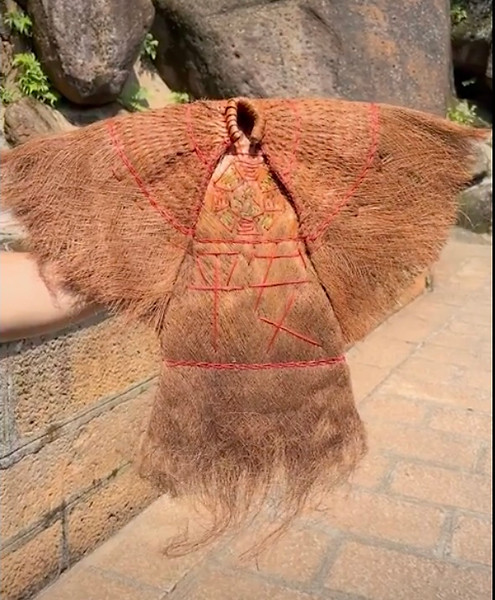
Ancient raincoat
Source: Jason Ong & Lin Zhou (林洲)
The image of an ancient raincoat offers a captivating window into the lives of the early Hinghua people in what is now Putian. Intricately sewn onto the chest are a hexagram symbol and the Chinese characters 平安 (meaning “peace and safety”), elements rich with meaning and cultural significance.
These symbols likely reflected the deep yearning of the people at the time. Wearied by the toll of wars and natural calamities, they sought peace not just in their hearts but in every aspect of life, even in the garments they wore. The hexagram, possibly representing divine order, and the hopeful message of 平安 may have served as both a prayer and a silent plea: that the heavens might hear their cries for protection and grant them safety from conflict and disaster.
The fiber of the coat is believed to have been made from the sheaths of palm leaves. Though primitive in appearance, it reflects an early form of natural technology. This same material is still used today to make mattresses, prized for their ability to keep people warm in winter and cool in summer due to its natural heat-regulating properties. It’s likely that the raincoat served multiple purposes, providing protection not only from rain, but also from the seasonal extremes of heat and cold.
Origins and Migration of the Hinghwa People
The Hinghwa ethnic group, historically known as the 'Min' people, were originally located in the southern regions of China. Over time, they gradually merged with northern populations during the Warring States period.
During that era, the Yue and Chu kingdoms held power in the central and southern regions of present-day Zhejiang. At the time, Zhejiang included the northern part of today’s Fujian Province. After the Yue kingdom was defeated in battle, members of the Yue clan fled southward toward the 'Ou' (瓯) region, now known as Wenzhou in Zhejiang, near Fujian's northern border. The Yue ethnic group (越族) was also referred to as the YuYue (于越), as the surname of their king was 'Yu' (于).
Professor Chen C. Y. explains:
“During the Qin and Han dynasties, Han people continued their expansion southward into the Putian area. This southern migration occurred multiple times: first during the initial expansion, then during the Yongjia Rebellion (永嘉之乱), and again at the end of the Jin Dynasty following a peasant uprising.”
This migration led the people of the Ou region and the Yue ethnic group to move further south into the Min (Fujian) area. Historically, the Min people were also known as the "Southern Man" (南蛮), or southern tribal peoples. Through integration with other groups, a new ethnic identity gradually formed.
As Professor Chen, Dean of Putian University, states:
“The Hinghwa people belong to the Minyue ethnic group (闽越族).”
The earliest records of a city called "Min" in Fujian Province appear in the ancient Chinese encyclopedia The Classic of Mountains and Seas (Shan Hai Jing), specifically in Volume 10, The South of the Sea: “Fujian is in the sea, and there are mountains to the northwest. One day, Fujian Zhongshan is in the sea.”
(Huang, 2012a, p. 2).
This description aptly reflects the geography of Putian, which was historically inundated during high tides. The ancient Qiantian city is known today as Putian and Xianyou.
Fujian Province is typically divided into three major cultural and linguistic regions:
-
Mindong (闽东; Eastern Fujian): Encompasses the middle and lower Min River basin and the northeastern mountains, adjacent to the Taiwan Strait and the East China Sea.
-
Minnan (闽南; Southern Fujian): Refers to areas around the Jiulong River (九龙江) and Jin River Basin (晋江流域), also near the Taiwan Strait.
-
Minzhong (闽中; Central Fujian): Includes parts of Sanming City (三明市) and the Putian area, including Xianyou County (仙游县), Licheng District (荔城区), Chengxiang District (城厢区), Xiuyu District (秀屿区), and Hanjiang District (涵江区).
According to Professor Chen C. Y.:
“The Minyue ethnic group (闽越族) was composed of several ethnic lineages, and the Hinghwa clan was among them.”
He categorizes the Minyue group into three main components:
-
The indigenous Min tribes, known as the "Seven Min" (七闽) tribal alliances dating back to the Shang and Zhou dynasties.
-
Southern migrants from the Yue royal clan and their followers.
-
People from the Chu kingdom who migrated into Fujian.
During the Shang and Zhou dynasties, the Putian area was under the administration of the Yang State (扬州), one of the seven regions of the Western Zhou. By the Qin Dynasty, it became part of the Minzhong Commandery (闽中郡). The name “Putian” did not exist at that time.
As the victorious Han army advanced southward, they gradually merged with the local Yue populations. During the Warring States period, the Min people and the YuYue ethnic group (于越族) fused into what became known as the Baiyue (百越). This fusion was documented by the historian Sima Qian.
Professor Chen affirms:
“The early ancestors of the Xinghua (Hinghwa) people were part of the Minyue ethnic group (闽越族).”
These people were among the earliest inhabitants of what would become the Putian region. Thus, it can be concluded that the Xinghua (Hinghwa) people originally belonged to the Minyue ethnic lineage.
According to Professor Chen:
“Before their integration with the Han from the north, the only recorded surnames among them were Lan (蓝), Lei (雷), Che (车), and Yi (蚁).”
Zhou (2008) further notes:
“During the Tang Dynasty, 30 surnames migrated to Putian, including Zhang (张), Fang (方), Mi (米), Chen (陈), Ye (叶), Qiu (邱), Zhan (詹), Xie (谢), and Fu (傅), especially in the Xianyou area.”
Migration, however, was an ongoing process. Over time, more surnames were introduced. This interaction between the northern migrants and the southern tribes was ultimately beneficial. The northern Han people brought advanced production technologies and cultural practices, contributing to the development of the southern regions.
After settling in Fujian, the Han people eventually formed six major ethnic groups:
-
Xinghua people (兴化人; Xīnghuà rén)
-
Fuqing people (福清人)
-
Fuzhou (Hockchiu) people (福州人)
-
Jiannan people (间南人)
-
Minbei people (闽北人)
-
Hakka people (客家人)
-
Longyan people (龙岩人)
Each group developed its own dialect, often becoming as distinct as different "birds of a feather flocking together."
By around 900 AD, near the end of the Tang Dynasty, large-scale migrations from the north had begun to taper off. By that time, the Xinghua people had firmly established themselves in the Putian region and were rising in cultural and social prominence.
The expansion of the Han ethnic group across the central plains and further south during the Qin and Han dynasties led to the assimilation of many minority groups. This process contributed to the Han becoming the majority ethnicity in China. Intermarriage and cultural integration further accelerated this population growth and cohesion.
From the Ruins of Civilization, the Character
— 化 —
Emerged.
Putian was once described by its own residents as “one huge slum.” Today, it has transformed into a thriving metropolis of highways and skyscrapers. I consider it my good fortune to have witnessed the remarkable transformation of not just one, but two nations in my lifetime, first Singapore, and now China, particularly Putian. As the following video illustrates, the people of Putian have every reason to proudly declare, “We are Putian People.”
The Chinese character ‘化’ (huà) has a profound meaning and came to represent a people who were reputed to be deeply connected to education.
This image is believed to be an illustrative representation of the actual inscription found on an oracle bone. Zhihu (知乎), in its Interpretation of Oracle Bone Inscriptions, presents it as:
Ancient ‘化’
Source: Zhihu (2023)
Some people interpret the word Hinghua (兴化) as "lucky people", because the word ‘化’ (huà) sounds very similar to ‘华’ (huá). In a sense, it is true that the Hinghua people were fortunate to survive the worst of times and went on to triumph over adversity. This is perhaps an understatement for a people who survived three great calamities during the Yuan, Ming, and Qing Dynasties.
While the word ‘兴’ (xīng) means to rejuvenate, rise, flourish, or prosper, the word ‘化’ (huà) carries a deeper meaning when traced back through time.
The character ‘化’ evolved from an image first found on oracle bones during the Shang Dynasty (c. 1600–1046 BCE) (Dong, 2011b). It resembles two people with their backs to each other, placed vertically opposite -- one standing upright facing left, the other upside down facing right.
This simple illustration conveys a profound meaning in Chinese thought. It can represent seeing things from a different perspective before reaching a conclusion.
It symbolizes fluidity or transformation in one’s perception. Over time, this evolved into the character ‘化’, which in a modern context means “to transform into a certain nature or state.”
In one of Lao Zi’s teachings, he advises one to be like water -- that is, to adapt according to the circumstances. Ironically, this name befits the Hinghua people well, given their ingenuity in adapting to different environments, whether in times of prosperity or hardship.
This adaptability may explain why the Hinghua people were able to survive the many calamities that befell Putian and later re-emerge in the Nanyang region to play a significant role in ushering in its golden age.
The word 兴化 (Hinghua) was first used by Confucius in his teaching ‘兴盛教化’, which means “to prosper” and “to revitalize or educate” (Xinghua, n.d.). It can also mean enlightening people through education and culture.
In 979 AD, the term gained another meaning during the Song Dynasty’s Taiping era, when a region was carved out of Quanzhou and named Xinghua County.
The name was bestowed by Emperor Taizong aka Zhao Jiong (趙炅). At the time, he sought to address the instability caused by peasants living in the outer regions. He believed that using education to uplift and civilize the people would be an effective strategy. This marked the first time the name Xinghua became associated with Putian, giving rise to the people known as ‘兴化人’ (Xinghua rén).
The name 兴化 (Hinghua) is said to be an abbreviation of ‘兴德化民’, meaning to educate and uplift the people through moral virtue.
This philosophy may have laid the foundation for the Hinghua people’s continued progress and their remarkable contributions throughout history. One of these was to earn the honorable title of "文献名邦,海滨邹鲁".


Emperor Taizong, also known as Zhao Jiong (趙炅), bestowed the name ‘兴化’ (Xinghua) on a newly established county carved out of Quanzhou. This marked the first time the name Xinghua became associated with Putian, giving rise to the identity of the people known as ‘兴化人’ (Xinghua rén).
Emperor Taizong aka Zhao Jiong (趙炅)
Source: Hui Min
我们是莆田人
Source: Jiang (2025). 我们是莆田人. (Xiaohongshu).

© 2025. Copyright Jason Ong
作者: 王顺龙, 新加坡
All Rights Reserved
